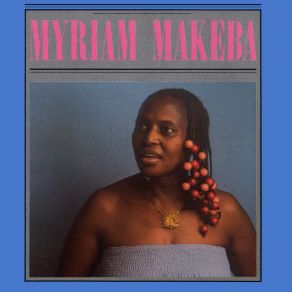Myriam Makeba
Download links and information about Myriam Makeba by Myriam Makeba. This album was released in 1960 and it belongs to Rock, World Music, Songwriter/Lyricist genres. It contains 14 tracks with total duration of 56:40 minutes.

|
|
|---|---|
| Artist: | Myriam Makeba |
| Release date: | 1960 |
| Genre: | Rock, World Music, Songwriter/Lyricist |
| Tracks: | 14 |
| Duration: | 56:40 |
| Buy it NOW at: | |
| Buy on iTunes $7.99 | |
| Buy on Amazon $6.99 | |
Tracks
[Edit]| No. | Title | Length |
|---|---|---|
| 1. | The Retreat Song | 4:10 |
| 2. | Suliram | 3:44 |
| 3. | The Click Song | 5:13 |
| 4. | Umhome | 3:31 |
| 5. | Olilili | 3:56 |
| 6. | Lakutshn Ilanga | 2:46 |
| 7. | Mbube | 6:06 |
| 8. | The Naughty Little Flea | 3:44 |
| 9. | Where Does It Lead | 4:07 |
| 10. | Nomeva | 3:40 |
| 11. | House of the Rising Sun | 2:45 |
| 12. | Saduva | 4:02 |
| 13. | One More Dance | 4:50 |
| 14. | Iya Guduza | 4:06 |
Details
[Edit]Miriam Makeba had just made a splash in New York nightclubs and earned a fistful of press only a few months earlier when RCA Victor Records snapped her up and recorded her first album in May 1960. Clearly, the label was hoping to repeat the success of her mentor, Harry Belafonte, whose Belafonte Folk Singers accompanied her on some tracks and who wrote a blurb for the album's back cover. Like Belafonte, she was a black singer with an exotic, folk-based repertoire who could translate her music into a sophisticated club act. In addition to the Belafonte troupe, which appeared on the calypso tune "The Naughty Little Flea," a song that sounded like a Belafonte number, the Chad Mitchell Trio joined her on "Mbube," aka the Weavers' "Wimoweh," and Charles Coleman was her duet partner on the comic Austrian tune "One More Dance." She also turned in an early version of "House of the Rising Sun." Such familiar material offset the songs sung in her native South African tongue of Xhosa. Makeba had an expressive voice and was extremely versatile, as the range of material indicates. But despite the critical raves, she may have been a bit too exotic to be commercial on her first album, which was not a big seller. RCA let her go to Kapp Records for her second album, but came calling again three years later.